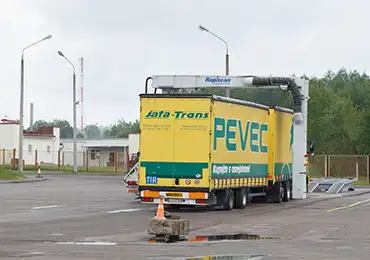Methods of inspecting goods
Container Scanning Technology
In case of container shipping to USA from UK or from other countries or continents, there are a lot of protocols that are involved. It kick-starts with the booking process and goes down to the loading, the tracking and then the ultimate – clearance from the custom officials. The clearance stage is sometimes a big headache for some firms, especially when they know they have gone against the laws spelt out by the government of the country their goods will arrive as regards to importation of the goods in question. The smuggling of contraband goods into countries has led to the extra strictness in the checkmating of containers as soon as they arrive at sea ports. Container scanning technology has been introduced to facilitate this.
Container scanning, also known as non-intrusive inspection (NII) can be referred to a safe and easy means of detecting and inspecting goods in any transportation system. In the world of importation and exportation, this is more of a necessity considering the fact that goods travel from country to country and at times, from continent to continent and can serve as a means of direct or indirect attacks.
 The introduction of the idea of container scanning come about in the United States of America and is being enforced by some Organizations like the Department of Homeland Security and the Container Security Initiative (CSI). The establishment of these Organizations and the likes of them are aimed at ensuring that there is a thorough inspection done on, if possible, all containers that gets in and, sometimes, out of the country.
The introduction of the idea of container scanning come about in the United States of America and is being enforced by some Organizations like the Department of Homeland Security and the Container Security Initiative (CSI). The establishment of these Organizations and the likes of them are aimed at ensuring that there is a thorough inspection done on, if possible, all containers that gets in and, sometimes, out of the country.
Container scanning is a security-enhancement technology innovated specially for the detection of harmful goods – special nuclear materials and contraband drugs, for instance. The quest for accuracy and extra advancement in the aspect of container shipping has led to the innovation of different technologies of container scanning. These technologies include:
Gamma-ray radiography
Using cobalt-60 or caesium-13 as a radioactive element, and a tower of gamma detectors, this scanning system can scan trucks, producing reasonably visible images. It produces images of the scanned in different dimensions. This is achieved by either moving the scanning hardware or the material to be scanned. The radioactive sources have high and varying penetrating power. For instance, the cobalt-60 can grab images of containers whose thickness is as much as 15-18cm, if made of steel.
X-ray radiography
This scanning technology has no difference with the gamma-ray radiography. However, while the gamma-ray radiography uses a radioactive source, X-ray radiography uses a high-energy Bremsstrahling spectrum. It is regarded as a more advanced scanning machine than the gamma-ray. It has a whopping penetrating power of 30-40cm on steel. A more scintillating ability this technology has is that of perfectly scanning containers on vehicles moving with not more than a speed of 13km/hr, perhaps, the reason why they are more expensive to acquire and operate. There are diverse adoptable mechanisms in this container scanning technology.
Neutron Activation System
This technology can achieve the aim of scanning through three different approaches, Thermal Neutron Analysis (TNA), Fast Neutron Analysis (FNA) and Pulsed Fast Neutron Analysis (PFNA). Each of these three systems work through the interaction of neutrons with the container under inspection. While the TNA generates gamma-rays using thermal neutron capture, FNA and PFNA do theirs by scattering fast neutrons. PFNA, having a pulsed culminated neutron beam, produces better and more convincing images than the initial two systems – a 3-dimension image.
Passive Radiation Detectors
This is another container scanning technology that is widely used at sea ports and harbours worldwide. It is of two distinct types, Gamma Radiation Detectors (GRD) and Neutron Radiation Detectors (NRD). These two systems have the ability to detect neutrons emitted by radiological and fissile materials respectively.
The two systems in this technology have limitations for which they are being criticized. GRD suffers from the inability to distinguish gammas being emitted by nuclear sources from that of those emitted by harmless radiological materials such as bananas, porcelain, stoneware, cat litter, granite etc. this causes problems for custom officials while using this container scanning technology. For NRD which makes use of Helium-3, the scarcity of Helium-3 triggers the need for an alternative. However, the combination of the GRD and NRD systems makes this technology efficient enough for custom officials.
Container scanning is a very helpful tool when it comes to security. It has gone a long way in the effective checkmating of imported and exported good that may be harmful. It should be greatly encouraged.


